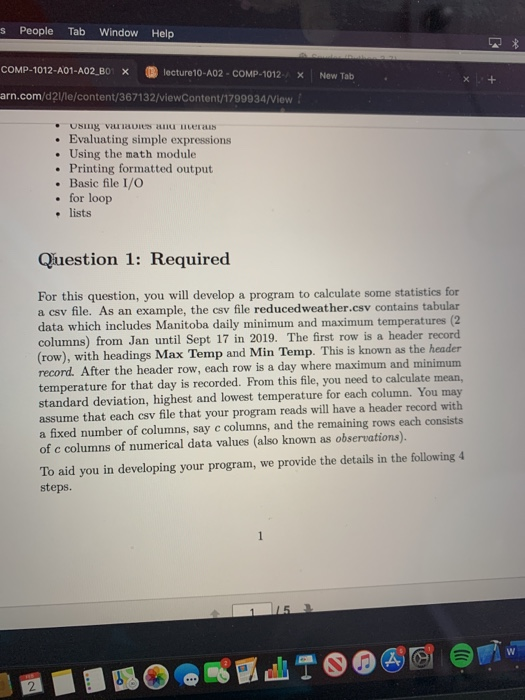s People Tab Window Help COMP-1012-A01-A02 BOX lecture 10-A02-COMP-1012x New Tab arn.com/d21/1e/content/367132/ViewContent/1799934/View Usmg var am mers Evaluating simple expressions Using the math module Printing formatted output Basic file I/O for loop lists Question 1: Required For this question, you will develop a program to calculate some statistics for a csv file. As an example, the csv file reduced weather.csv contains tabular data which includes Manitoba daily minimum and maximum temperatures (2 columns) from Jan until Sept 17 in 2019. The first row is a header record (row), with headings Max Temp and Min Temp. This is known as the header record. After the header row, each row is a day where maximum and minimum temperature for that day is recorded. From this file, you need to calculate mean, standard deviation, highest and lowest temperature for each column. You may assume that each csv file that your program reads will have a header record with a fixed number of columns, say c columns, and the remaining rows each consists of c columns of numerical data values (also known as observations). To aid you in developing your program, we provide the details in the following 4 steps. s People Tab Window Help COMP-1012-A01-A02 BOX lecture 10-A02-COMP-1012x New Tab arn.com/d21/1e/content/367132/ViewContent/1799934/View Usmg var am mers Evaluating simple expressions Using the math module Printing formatted output Basic file I/O for loop lists Question 1: Required For this question, you will develop a program to calculate some statistics for a csv file. As an example, the csv file reduced weather.csv contains tabular data which includes Manitoba daily minimum and maximum temperatures (2 columns) from Jan until Sept 17 in 2019. The first row is a header record (row), with headings Max Temp and Min Temp. This is known as the header record. After the header row, each row is a day where maximum and minimum temperature for that day is recorded. From this file, you need to calculate mean, standard deviation, highest and lowest temperature for each column. You may assume that each csv file that your program reads will have a header record with a fixed number of columns, say c columns, and the remaining rows each consists of c columns of numerical data values (also known as observations). To aid you in developing your program, we provide the details in the following 4 steps







